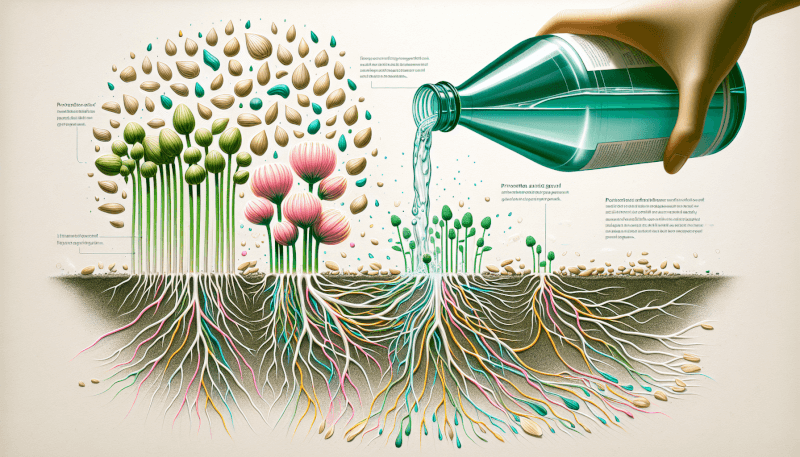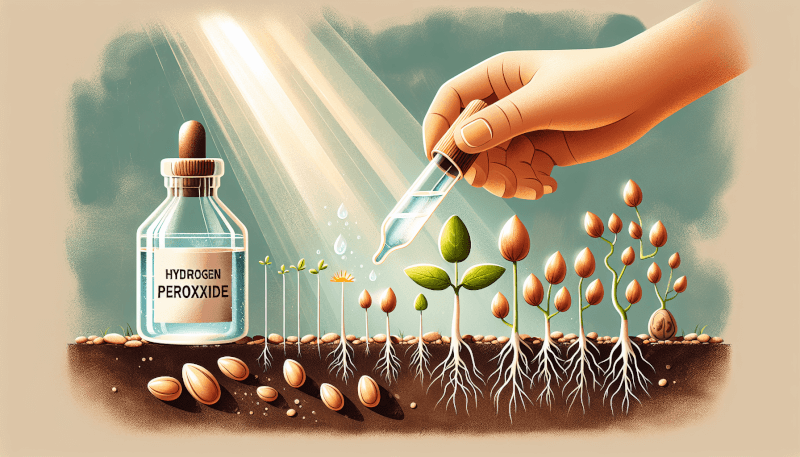👋 Click the mic button to talk to Alfred, the Todd's Seeds Gardening/Sprouting Expert – Feel free to ask him anything!
Ask Virtual Todd Anything - Click the Mic
Do you want to enhance the success rate of germinating seeds? Look no further than hydrogen peroxide. This versatile compound possesses the ability to aid in the germination process by increasing oxygen levels, reducing the risk of fungal growth, and promoting overall seed health. By simply adding a small amount of hydrogen peroxide to your water or soil mix, you can give your seeds the best possible chance at thriving. Say goodbye to disappointing sprouts and hello to vibrant, healthy plants with the help of hydrogen peroxide.
Benefits of Using Hydrogen Peroxide for Germinating Seeds

Improved Germination
When it comes to germinating seeds, hydrogen peroxide can provide a significant boost. The use of hydrogen peroxide helps to break down the seed coat, allowing moisture and oxygen to penetrate the seed more easily. This improved moisture and oxygen availability stimulates the germination process and increases the overall germination rate. With hydrogen peroxide, you can expect faster and more uniform germination, giving your plants a head start in their growth.
Increased Seed Viability
Hydrogen peroxide has been found to increase the viability of seeds, meaning a greater percentage of seeds will successfully grow into healthy plants. The oxygen-rich environment created by hydrogen peroxide aids in seed respiration, enhancing the metabolic processes necessary for germination. By promoting healthy cellular respiration, the seeds are better equipped to absorb nutrients and establish a strong foundation for growth.
Enhanced Root Development
Root development is crucial for plants to establish a strong foundation and access essential nutrients and water from the soil. Hydrogen peroxide helps to stimulate root growth by increasing the availability of oxygen in the germination environment. The extra oxygen promotes the development of a robust root system, allowing the plants to establish themselves quickly and efficiently. By using hydrogen peroxide, you can encourage strong and healthy roots, leading to overall plant vigor.
Protection Against Seed-Borne Diseases
One of the often-overlooked benefits of using hydrogen peroxide for germinating seeds is its ability to protect against seed-borne diseases. Hydrogen peroxide has antimicrobial properties that can help eradicate harmful pathogens present on the surface of seeds. By treating your seeds with hydrogen peroxide, you can minimize the risk of seedling infections and increase the chances of a successful germination process. This added layer of protection ensures that your plants have a healthy start and are less susceptible to diseases.
Preparing Hydrogen Peroxide Solution
Choosing the Right Hydrogen Peroxide Concentration
The concentration of hydrogen peroxide used for germinating seeds is an essential factor to consider. It is crucial to choose the appropriate concentration to ensure the optimal balance of oxygenation and protection without causing harm. Generally, a 3% hydrogen peroxide solution is suitable for most seeds. However, some more delicate or robust seeds may require a higher or lower concentration. Always refer to seed-specific recommendations or consult with a horticulturist for guidance on the appropriate hydrogen peroxide concentration for your seeds.
Mixing Hydrogen Peroxide with Water
To create the hydrogen peroxide solution, you will need to dilute the hydrogen peroxide with water. The ratio of hydrogen peroxide to water will vary depending on the concentration you are using and the seed type. As a general guideline, a ratio of 1 part hydrogen peroxide to 10 parts water is a good starting point. This ratio provides the right balance of potency and safety for most seeds. However, it is crucial to refer to specific seed recommendations for the best results.
Recommended Ratios for Different Seed Types
Different types of seeds may benefit from slightly varying ratios of hydrogen peroxide to water. Some seeds, such as vegetable seeds, may require a stronger solution to break down their tougher seed coats. On the other hand, more delicate seeds, like flower seeds, may need a gentler solution. It is important to research or consult seed-specific resources to determine the best hydrogen peroxide to water ratio for the seeds you are germinating. The right ratio will ensure optimal results and promote successful germination.
Methods of Treating Seeds with Hydrogen Peroxide
Soaking Method
The soaking method involves immersing the seeds in a hydrogen peroxide solution to enhance germination. To use this method, prepare the hydrogen peroxide solution according to the recommended ratios and place the seeds in a container. Pour the solution over the seeds, ensuring that they are fully submerged. Allow the seeds to soak for the suggested duration, which will vary depending on the seed type. After soaking, rinse the seeds thoroughly with water to remove any residue before planting them.

Spraying Method
The spraying method involves applying the hydrogen peroxide solution directly to the surface of the seeds. Fill a spray bottle with the prepared hydrogen peroxide solution and lightly mist the seeds until they are evenly coated. This method is particularly useful for small or delicate seeds that may become damaged or lose viability when soaked. Ensure that the seeds are evenly coated, but avoid saturating them. Allow the seeds to air dry briefly before planting them.
Applying Hydrogen Peroxide as a Seed Coating
Seed coating is another effective method for treating seeds with hydrogen peroxide. To apply the seed coating, mix the hydrogen peroxide solution with a suitable dry additive, such as vermiculite or sand. The ratio of hydrogen peroxide to additive will depend on the specific seed type and their coating requirements. Once the solution and additive are thoroughly mixed, add the seeds and gently shake or stir to ensure even coating. Allow the coated seeds to air dry before planting.
Techniques for Soaking Seeds in Hydrogen Peroxide
Duration and Frequency of Soaking
The duration and frequency of soaking seeds in hydrogen peroxide will depend on the seed type and its specific germination requirements. Generally, soaking seeds for 12-24 hours is sufficient for most seeds. However, some seeds may require longer soaking periods or multiple soaking cycles. Always refer to seed-specific instructions or guidelines to determine the ideal soaking duration and frequency. Over-soaking can lead to mold or excessive water uptake, so it is important to follow the recommended guidelines.
Temperature Considerations
Temperature plays a crucial role in seed germination, and soaking seeds in hydrogen peroxide is no exception. For optimal results, maintain a consistent temperature during the soaking process. Most seeds prefer warmer temperatures between 70-85°F (21-29°C) for germination. However, some seeds may require specific temperature ranges, so it is advisable to research or consult seed-specific resources for the ideal soaking temperature. Providing the right temperature ensures that the seeds receive the necessary conditions for successful germination.

Precautions and Safety Measures
While hydrogen peroxide is generally safe to use, it is important to take precautions to ensure personal safety and seed viability. When handling hydrogen peroxide, always wear gloves and protective eyewear to prevent contact with the skin or eyes. Additionally, work in a well-ventilated area to avoid inhalation of fumes. Keep hydrogen peroxide away from children and pets, as it can cause harm if ingested. Proper handling and storage of hydrogen peroxide will ensure a safe and effective germination process.
Spraying Seeds with Hydrogen Peroxide
Preparing the Spray Solution
To create the hydrogen peroxide spray solution, mix the hydrogen peroxide with water according to the recommended ratios. As each seed type may have different requirements, refer to specific seed recommendations for the best dilution ratio. Fill a spray bottle with the prepared solution and ensure that it is well-mixed. It is important to use a clean spray bottle to avoid any contamination that may affect the efficacy of the hydrogen peroxide solution.
Application Techniques
When spraying seeds with hydrogen peroxide, it is crucial to ensure even coverage without saturating the seeds. Hold the spray bottle at a distance and mist the seeds gently until they are evenly coated. Ensure that the spray is fine enough to cover the seeds without causing them to clump together. If needed, adjust the nozzle of the spray bottle to achieve the desired spray pattern. Be mindful of the force of the spray, as excessive pressure can damage delicate seeds.
Ideal Timing for Spraying
The ideal timing for spraying seeds with hydrogen peroxide will vary depending on the seed type and its specific germination requirements. Some seeds may benefit from pre-soaking before spraying, while others may require direct spraying onto dry seeds. Research or consult seed-specific resources to determine the ideal timing for spraying. It is important to follow the recommended guidelines to ensure that the seeds receive the maximum benefits of hydrogen peroxide for germination.
Seed Coating with Hydrogen Peroxide

Advantages of Seed Coating
Seed coating with hydrogen peroxide offers several advantages for germination. Coating the seeds provides a protective layer that helps retain moisture and prevents the seeds from drying out. It also facilitates even distribution of the hydrogen peroxide solution, ensuring uniform penetration and seed treatment. Seed coating is particularly beneficial for small or irregularly-shaped seeds that may be challenging to handle or soak. The coating process improves handling and allows for precise application of hydrogen peroxide.
Procedure for Coating Seeds
To coat seeds with hydrogen peroxide, follow a simple procedure that ensures thorough and even coverage. First, mix the hydrogen peroxide solution with a suitable dry additive, such as vermiculite or sand. The ratio will depend on the specific seed type and its coating needs. Add the seeds to the mixture and gently shake or stir until the seeds are evenly coated. Allow the coated seeds to air dry briefly before planting them to prevent clumping.
Recommended Additives for Seed Coating with Hydrogen Peroxide
When coating seeds with hydrogen peroxide, it is important to choose suitable additives that enhance seed treatment without causing harm. Additives like vermiculite, sand, or finely ground coconut coir provide an ideal coating medium. These materials help create a porous and water-retentive coating that promotes seed germination while allowing oxygen diffusion. Additionally, additives like beneficial fungi or bacteria may be included to facilitate the development of symbiotic relationships with the seeds for improved root growth and nutrient uptake.
Precautions and Safety Measures
Choosing the Right Hydrogen Peroxide Concentration
Selecting the appropriate hydrogen peroxide concentration is crucial to ensure the safety and efficacy of the treatment. Higher concentrations, such as 6 or 9%, may be too strong for most seeds and can potentially damage or inhibit germination. Conversely, too low of a concentration, below 3%, may not provide sufficient oxygenation or germicidal effects. It is important to carefully choose the hydrogen peroxide concentration that aligns with the specific seed requirements to achieve optimal results and minimize any adverse effects.

Avoiding Overexposure to Hydrogen Peroxide
While hydrogen peroxide is generally safe to use, prolonged or excessive exposure can be harmful. Always follow the recommended guidelines for the duration and frequency of seed treatment. Avoid over-soaking, over-spraying, or over-coating the seeds, as excessive hydrogen peroxide can adversely affect seed viability. Additionally, individuals should avoid direct contact with hydrogen peroxide on the skin or eyes and should promptly rinse with water if exposure occurs. Adhering to proper safety measures ensures a safe and successful germination process.
Proper Handling and Storage of Hydrogen Peroxide
To ensure the longevity and effectiveness of hydrogen peroxide, it is essential to handle and store it correctly. Store hydrogen peroxide in a cool, dark place, away from direct sunlight, heat, or open flames. Avoid exposure to extreme temperatures, as this can degrade the quality of the hydrogen peroxide over time. Seal the container tightly and ensure it is stored in an upright position to minimize the risk of leaks or spills. Follow the manufacturer’s guidelines for proper disposal of hydrogen peroxide containers.
Considerations for Different Types of Seeds
Vegetable Seeds
Vegetable seeds come in a wide range of shapes, sizes, and germination requirements. Some vegetable seeds may benefit from pre-soaking or extended soaking periods to facilitate germination. Others may require special attention due to their hard seed coats, which may require a higher hydrogen peroxide concentration or longer soaking time. Research or consult seed-specific resources to ensure you are meeting the unique needs of each vegetable seed variety to achieve optimal germination.
Flower Seeds
Flower seeds also vary in their germination requirements and can benefit from hydrogen peroxide treatment. Delicate flower seeds may fare better with the spraying method or seed coating technique, as soaking can be detrimental to their viability. Stronger hydrogen peroxide concentrations may also be appropriate for flower seeds with tougher seed coats. Refer to seed-specific instructions or consult with horticulturists or local nurseries to determine the best treatment approach for your flower seeds.
Herb Seeds
Herb seeds typically have relatively small sizes and require specific germination conditions. Some herb seeds may need pre-soaking or seed coating techniques to break through their tough seed coats. Others may benefit from spraying with a gentler hydrogen peroxide solution. Research or consult seed-specific resources to determine the optimum germination conditions and treatment methods for your herb seeds.
Tree and Shrub Seeds
Tree and shrub seeds often have hard and resilient seed coats, making hydrogen peroxide treatment essential for successful germination. Soaking or seed coating techniques are particularly effective for tree and shrub seeds. Consider higher hydrogen peroxide concentrations or longer soaking periods to help soften the tough seed coats and improve germination rates. Refer to seed-specific guidelines or seek expert advice to ensure optimal conditions for germinating tree and shrub seeds.
Common Mistakes to Avoid
Using Excessive Hydrogen Peroxide
Using excessive amounts of hydrogen peroxide can be detrimental to seed germination. It is important to follow the recommended ratios and guidelines for each seed type, as higher concentrations or prolonged exposure can inhibit germination or damage seeds. Overexposure to hydrogen peroxide can cause the seeds to rot, develop mold, or become waterlogged. Avoid the temptation to add extra hydrogen peroxide, as it can do more harm than good. Following the recommended guidelines ensures healthy germination and promotes seedling success.
Lack of Proper Sterilization
While hydrogen peroxide provides protection against seed-borne diseases, it is important to note that it is not a substitute for proper sterilization of seeds. Before treating seeds with hydrogen peroxide, ensure that they are clean and free from contaminants. Remove any debris, damaged seeds, or traces of pathogens, as hydrogen peroxide may not fully eliminate pre-existing issues. Proper seed sterilization practices, such as soaking in diluted bleach or using hot water treatments, should be implemented along with hydrogen peroxide treatment for optimal results.
Ignoring Seed Characteristics
Each seed has unique characteristics that must be considered when using hydrogen peroxide for germination. Factors like seed size, dormancy requirements, and sensitivity to moisture will influence the best treatment approach. It is important to research or consult seed-specific resources to learn about any specific requirements or precautions for the seeds you are germinating. Being mindful of these seed characteristics allows for tailored treatment methods and promotes successful germination.
Monitoring Germination Progress
Observing Seed Germination
Monitoring the germination progress of the treated seeds is an essential step in ensuring successful plant growth. Regularly observe the seeds to track the rate and uniformity of germination. Look for signs of sprouting, such as the emergence of the root or shoot. Take note of any uncommon or stunted growth, as these may indicate potential issues. By closely monitoring the germination process, you can identify and address any problems early on, increasing the chances of healthy plant development.
Recording Data
Keeping a record of the germination progress is valuable for future reference and analysis. Document the date of seed treatment, duration and method of treatment, as well as the number of seeds treated. Record the number of seeds that germinate and the time it took for germination to occur. This data can help you identify patterns or trends in germination success and optimize your future germination strategies. By maintaining accurate records, you can continually improve your germination techniques.
Troubleshooting
If you encounter challenges or have seeds that are slow to germinate or fail to germinate, troubleshooting is essential. Check for potential issues such as incorrect treatment methods, improper seed storage conditions, or seed quality. Adjust your germination techniques accordingly based on the observations and data you have recorded. Be patient and make incremental changes to find the optimal germination conditions for each seed type. Troubleshooting is an ongoing process to refine and improve your germination success.
In conclusion, using hydrogen peroxide for germinating seeds offers several benefits, including improved germination, increased seed viability, enhanced root development, and protection against seed-borne diseases. By understanding the various methods of treating seeds with hydrogen peroxide and following proper techniques, you can effectively incorporate this natural aid into your germination process. Remember to consider the specific needs of different seed types, adhere to safety precautions, and monitor germination progress for optimal results. With hydrogen peroxide, you can give your seeds the best start, ensuring healthy and robust plant growth.